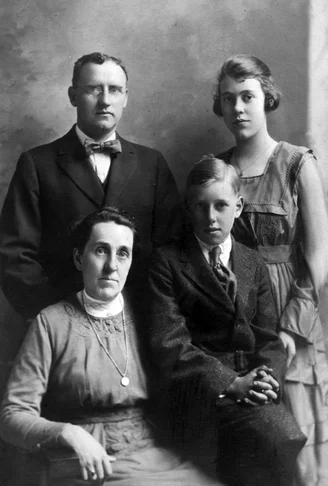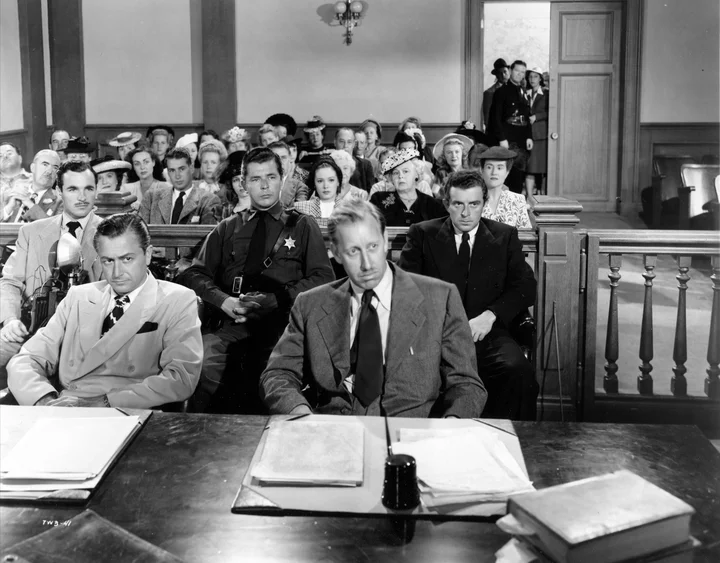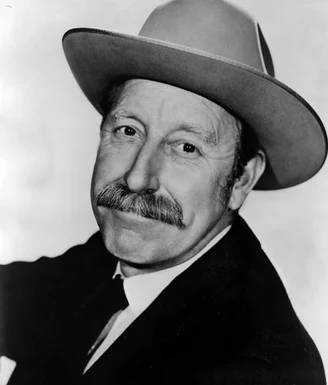They Won’t Believe Me, 1947, RKO Radio Pictures. Frank is defense attorney for Robert Young, at left, who is charged with murder. Classic film noir also starring Susan Hayward. RKO publicity photo.
###
Ferndale may be “Hollywood on the Eel” as the locale of the four movies “A Death in Canaan” (1978), “Salem’s Lot” (1979), “Outbreak” (1995), and “The Majestic” (2001), but Ferndale’s real gift to Hollywood was Frank Ferguson who, from 1940 to 1975, was one of the most recognizable faces in movies and television, appearing in over 175 movies and some 400 television programs.
How did it happen that this man destined to share the silver screen with such luminaries as James Stewart, Bette Davis, Marlene Dietrich, Rock Hudson, and Doris Day came to be born in Ferndale? The answer dates to 1893, when Thomas “Tom” Ferguson, Frank’s burgh — a farming region, about as close to the North Sea as Ferndale is to the Pacific Ocean. Yet why was Ferndale his destination? With thousands of Fergusons from Scotland in the United States, one could assume that Tom had a Ferguson relative in Humboldt County. But the Ferndale connection was through Tom’s mother. She was a Swain from England and her brother, John Swain, had come to Ferndale before 1875 to visit relatives. He soon married a Ferndale girl, fathered five children, and became the drawing card to bring his nephew, Tom Ferguson, to Ferndale.
Tom entered the business world of Ferndale’s Main Street, and within two years opened a cigar and confectionery store. It survived only one year. Though ambitious, he took a step back to become a clerk at Main Street’s White Front Store. Cyrus Boynton, one of the co-owners, liked Tom and opened his home to him for room and board. Love blossomed at the dinner table between Cyrus’s lovely sister Annie and Tom, and they were married in June 1900. Two years later, daughter Harriet was born, then baby Frank became the gift they received on Christmas Day, 1906.
In 1912, when Tom learned of the death of his father, he wrote and urged his mother Georgina to come to Ferndale and bring his sister Isabella, age thirty-two, and brother John, twenty-seven. The three arrived in Ferndale in early July. Sadly, there was no family reunion between Georgina and her brother, John Swain. Left a widower after the death of his wife during the stillbirth of their fifth child, Swain had fallen victim to alcohol, becoming persona non grata not only to the family, but to all of Ferndale.
Georgina, Isabella, and John, after briefly staying at the Ferguson family home on Van Ness Street, purchased a separate residence on Lincoln Street, near the Golden State creamery at the north end of town. John, or “Scotty” as he was called, would spend most of his life working at that creamery, the most important creamery in Humboldt County — its innovations had influenced the whole dairy industry, including the paper-wrapping of sticks of butter and the development of powdered milk.

The Thomas Ferguson family, Ferndale, circa 1920. Clockwise from top left: Tom Ferguson, children Harriet and Frank Ferguson, and Annie Boynton Ferguson. Photo courtesy Frank Jewett.
Young Frank grew up helping in the Ferguson Dry Goods Company, his father’s Main Street store, which had opened in 1918 in the IOOF Building. Ferndale really moved into the twentieth century during Frank’s early years. The beneficence of another Scotsman, Andrew Carnegie, reached Ferndale with the dedication in 1910 of the new Carnegie Library, which young Frank often visited. He and his parents attended a variety of musical, vaudeville, and motion picture nights at one of Ferndale’s two theaters: the Fern (1909) and the Valerie (1910), which had each been carved out of space within other buildings. (Ferndale’s first standalone theater, the Hart, was built in 1920.) Improved medical treatment arrived when Ferndale’s first hospital moved from Washington Street to Main Street and added up-to-date equipment. For Frank, this proved important, for sometime during his Ferndale grammar school days he suffered injury to his legs when the family Model T leaked gas into the seating area and caught fire.
Frank entered Ferndale High School in 1922 at a time when the school offered both dramatics and football with equal enthusiasm. To Frank’s good fortune the high school had an exceptional English and drama instructor, Thomas G. Allison, “an impeccable gentleman in appearance, and … a stickler in the use of good language and writing.”1 Allison quickly recognized Frank’s exceptional acting and singing talents and began coaching him in oratory and declamation, while giving him roles in dozens of plays. The voice that would become Frank’s “bread and butter” blossomed. His vocal talents were honed to such excellence that in his senior year he entered the annual Shakespeare Festival for high schools at the University of California at Berkeley in March 1926. Declaiming an oration of King Edward from Richard III, Frank won first place for California high schools of less than 500 students. The celebration in Ferndale was townwide: it was the first time a Humboldt County student had won a statewide contest! The university professors who were the judges wrote in their assessment that Frank’s “English was as near perfection as one could desire.”
The Shakespeare award opened the door for Frank to attend UC Berkeley upon his graduation from Ferndale High in 1926. In no time at all, he became an integral part of the university glee club and the Little Theater. In fact, in his second semester at UC, he had to make a decision: either to go to Washington with the glee club to serenade President Calvin Coolidge, or remain for a major role in a production of a Greek tragedy, Euripides’ The Trojan Women. He chose to stay and act. This decision lead to starring roles throughout his college career in both dramas and comedies, as well as singing roles in Gilbert and Sullivan operettas. He also took a great interest in directing and in his junior year the Little Theater initiated “a training school for students interested in drama and practical stagecraft” with Frank as its head.
So it was not surprising that in his senior year he won the prestigious Templeton Crocker scholarship to attend a graduate school for further studies in drama. He chose Cornell University. In 1930, after a post-graduation visit to Ferndale, he took the steamer Virginia from California through the Panama Canal to New York and the Ithaca campus. He spent two years at Cornell, living on a $1,500 annual stipend, and gained his master’s degree in dramatics.
With only an advanced degree in hand, he left Cornell in 1932 in the midst of the Great Depression, and he did his best to survive in theatrical activities. For several years, he directed plays at the Berkeley Playhouse Association, then took a production of the famed melodrama The Drunkard on a national tour including stops in Texas, New Orleans, and Chicago, where it played all summer. Though he was the director, he also took the lead as the mustachioed villain.
In 1936, he married Ruth Rosa, a San Francisco girl. Still determined to be an actor, he tried his hand in New York the next year and had a bit part in a Federal Theater play, but soon returned to California and a solid job as a director and actor at the Pasadena Playhouse, which was emerging as the state’s prime producer of young actors for nearby Hollywood. From 1937 to 1941, he directed a dozen plays and acted alongside other young actors, some of whom would become full-blown “movie stars,” such as Dana Andrews, Victor Mature and Robert Preston. Then, in 1940, a Warner Brothers scout spotted him. His thirty-five-year Hollywood career was launched.
For the rest of his life, Frank Ferguson would be one of the most utilized character actors on both screen and television. With their vast acting experience prior to coming to Hollywood, the character actors of Hollywood’s Golden Years — the unsung heroes of movies — gave any movie they were in a special quality. Among Ferguson’s close friends from his Pasadena Playhouse days was Edgar Buchanan, another character actor, often seen in westerns. Buchanan also had a Humboldt connection, for he had two sisters here: Kate Buchanan, who served for many years as dean of women at Humboldt State; and Gayle Buchanan Karshner, author, teacher, and historian. Gayle was married to Don Karshner, longtime dean of students at Humboldt State.
Frank witnesses a Babe Ruth miracle
Movie directors saw Frank’s abilities in minor roles, uncredited in many of his earliest movies. In just a few minutes on screen, he could be memorable. On his single scene in the 1948 movie The Babe Ruth Story, one critic wrote:
Ferguson proved himself an above-average actor by successfully pulling off the treacly scene in which Babe (William Bendix) says “Hi, kid” to Ferguson’s crippled son — whereupon the boy suddenly stands up and walks!
Two classic Ferguson roles are Mr. McDougal, the owner of the house of horrors in Abbott and Costello Meet Frankenstein, considered the comedy pair’s best movie; and the marshal in Johnny Guitar, the western that starred Joan Crawford and uniquely paired two women, not men, who were out to get each other.
Frank plays straight man to Bud Abbott.
Though Ferguson had the potential to star in films, he preferred character roles because he loved the variety and knew that as a character actor he would probably have work until the day he died. When television series took off in the 1950s and 1960s, he had roles in most of the long-running series, such as Lassie, Peyton Place, Bonanza, Laramie, The Andy Griffith Show, Perry Mason, and on and on.
Ferguson was described by Humboldt journalist and historian Andrew Genzoli as “he of the wrinkled brow, eyes set with a twinkle of humor and wisdom, and a well-groomed mustache.” One Hollywood historian summarized Ferguson as an actor who “was equally effective as a henpecked husband, stern military leader, irascible neighbor, merciless employer, crooked sheriff, and barbershop hanger-on.” Little surprise that such versatility would land him roles in some 170 movies and hundreds of television appearances from 1940 to 1976, sharing the screen with many of the great stars of the day.
Frank gets pushed around by a racist demagogue in Bonanza …
… until the Cartwrights set him straight.
“Contrary to impressions the public may get,” Ferguson told a local interviewer while on a visit to Ferndale, “screen stars are generally not conceited, brash, or self-centered, but more often are earnest, hardworking people, and easy to get to know.” He even had specific comments about some of them: Clark Gable and John Wayne were “marvelous people,” Alan Ladd was “a nice person,” Joan Crawford was “a hard worker, but scared everyone,” and Doris Day was a “very sweet person.”
Ferguson did not fail to return to Humboldt to visit friends and family. Relatives still remember him as the friendliest and most affectionate of persons. His Uncle John’s children especially looked forward to the visits of their “movie star” uncle, who would empty his pockets and pass out “fivers” to his younger cousins. His nephew Frank Jewett (son of Frank’s sister Harriet) recalls a special visit by Ferguson during Easter vacation in 1946. The two of them spent five days fishing on the Eel River at Weymouth Pool (between Fortuna and Scotia) and caught steelhead every day, including one ten-pounder.
Ferguson thrived on outdoor activities, including rockhounding and even training bird dogs, but hunting and fishing were his favorite pastimes. In Southern California, skeet shooting and duck hunting were passions pursued with friends in a private club in Lancaster, some fifty miles north of Los Angeles in the Antelope Valley, at a site owned by the famed Doheny family.
In the realm of sport, Frank Ferguson’s partner-in- arms was Robert Fuller, one of television’s best known Western stars as the lead in the Laramie series in the 1960s. Though twenty-seven years younger than Ferguson, Fuller had a deep admiration for the older man, regarded him as “a unique actor in the business,” and looked forward to his being a guest star on Laramie. A bond of friendship developed through the two men’s love of the outdoors. In the 1960s, gun companies such as Winchester would provide “expeditions” to special hunting sites for well-known movie and television actors, as well as other famous individuals. Ferguson and Fuller would accompany the likes of General Jimmy Doolittle, Roy Rogers, Glenn Ford, and Van Heflin on various trips, including antelope hunting in Lander, Wyoming and quail and pheasant hunting near Phoenix, Arizona. “Those were fabulous days for us sportsmen in the 1960s,” recalls Fuller, describing Frank as “an honest sportsman,” not one to ever bend the rules of hunting.
During those years, Frank became a serious collector of shotguns, one who would easily spend twenty or thirty thousand dollars on a gun that he wanted for his collection. Fuller recalls Frank telling him how he had to “lie a little” about the cost of the shotguns when his wife Ruth became annoyed at the accumulation of guns in the house. When she would ask the price, the response went something like, “Just about $250, dear.” According to Ferguson’s nephew, Frank Jewett, the actor told him that “the guns were his retirement plan and he would sell one off every once in a while as needed.” (Jewett inherited what was left of the collection: “Two or three of his ‘users,’ that were top quality guns, but fairly well beat up.”)
Frank and his wife Ruth had a home overlooking the San Fernando Valley. Ruth died in 1967. A year later Frank married Dorothy Ann Baker, but sadly she died seven years later. With no children from either marriage and few roles coming his way after 1975, he spent more time with acting friends. There was one famed Hollywood “watering hole” that Frank frequented: the Cock ’n Bull pub on Sunset Boulevard, a favorite hangout for actors young and old, and where the likes of F. Scott Fitzgerald and Somerset Maugham hovered at the bar in earlier days. Frank Jewett recalls that he once visited the actor, who took him to the pub and “introduced me to every patron in the place!” Robert Fuller also remembers those great days with Ferguson and the other habitués of the Cock ’n Bull.
In 1977, film historian David Del Valle visited the pub, and writes that he caught up with “a trio of character actors getting rather stiff at the corner of the bar. The trio was instantly recognizable from a lifetime of working in TV and films. First there was Frank Ferguson… Next was the Maytag repairman himself, Jesse White.” And soon after, Del Valle recalls, the great actor John Carradine (the itinerant ex-preacher in The Grapes of Wrath) sauntered into the pub and immediately greeted Frank with a favorite nickname and the atmosphere exploded with shared recollections of the good old days of the movies.
A year later, Frank began a slow and painful exit. It would be these friends and especially those from his skeet shooting and duck hunting days out in Lancaster who helped take care of him in his final days before he died of cancer on September 12, 1978.
Perhaps it is no surprise that at Frank’s funeral service his friends would remember him not so much as an actor, but as a friend, one with whom they shared early morning duck blinds in Lancaster. George Nichols, a former agent, recalled that the actor was “not an overly religious man,” but “I will never forget what he said one Sunday morning in a blind. The sun was just coming up over the horizon, and ducks were flying all around us [and] he said, ‘George. We are in Heaven.’” Lastly, Dr. Ted Lynn, a physician friend, spoke to the heart of the man:
God in his wisdom made all kinds of people. But he did bestow on a few of his creatures special qualities of gentleness and kindness and of courage, which in a sense makes them a breed apart…This was Frank Ferguson all the way.
In a true Hollywood ending, his friends spread his ashes over his favorite duck blind at the Lancaster hunting club.
Frank, playing a defense attorney, opens the action in the 1947 RKO noir thriller They Won’t Believe Me.
ACKNOWLEDGMENTS
A shorter version of this article was published in “Our Story,” the bimonthly magazine of the Ferndale Museum, 515 Shaw Avenue, Ferndale, CA 95536.
Many people provided information for this article and I would like to extend my thanks to all of them:
- Don Anderson, Ann Roberts, and Mary Ellen Boynton of the Ferndale Museum.
- Floyd Bettiga (whose family lived across the street in Ferndale from the John Fergusons).
- The relatives of Frank Ferguson: Frank Jewett, Velma Ferguson, and Michelle Murphy Ferguson.
- Nina (Mrs. Robert) Brown of the Swain family side. Robert Fuller, actor (Interview by phone: Jan. 11, 2014).
- But special thanks must go to Frank Jewett, the nephew of Frank Ferguson, who not only supplied numerous key pieces of information about Frank, but also many of the photos.
###
The story above is from the Summer 2014 issue of the Humboldt Historian, a journal of the Humboldt County Historical Society. It is reprinted here with permission. The Humboldt County Historical Society is a nonprofit organization devoted to archiving, preserving and sharing Humboldt County’s rich history. You can become a member and receive a year’s worth of new issues of The Humboldt Historian at this link.


CLICK TO MANAGE